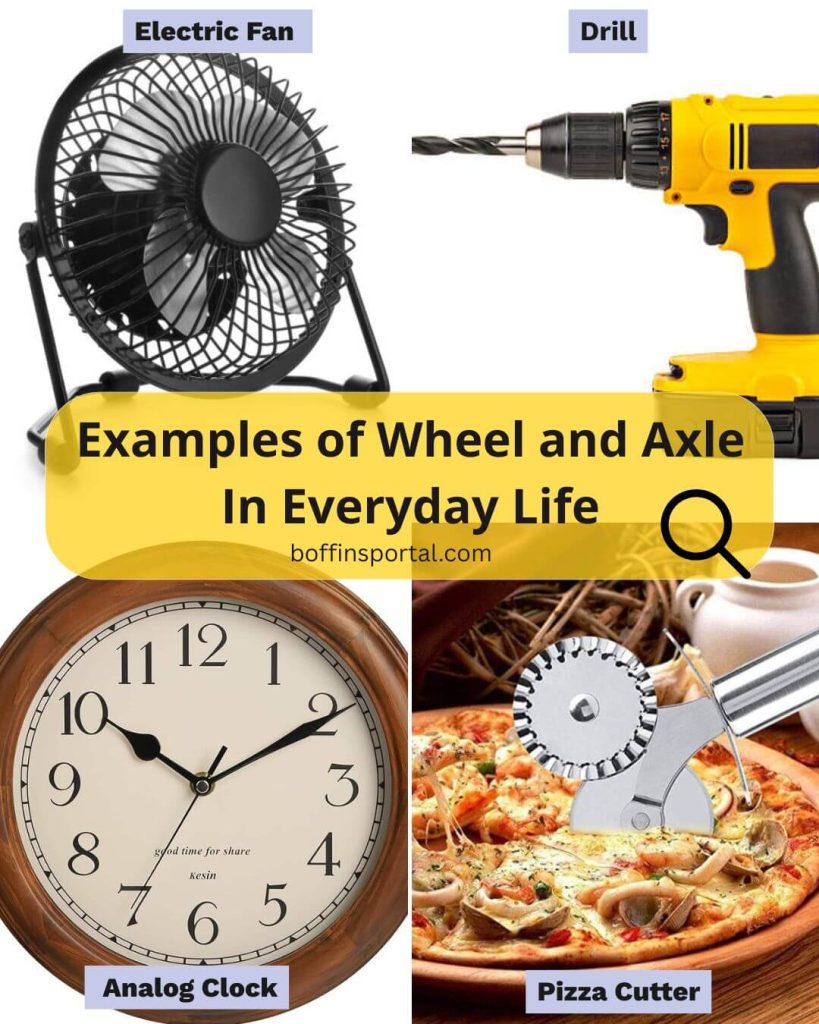A wheel and axle is a simple machine composed of a wheel attached to a smaller axle, enabling the transfer of force to accomplish tasks like lifting or moving objects more efficiently.
Types of Wheel and Axle Machines
The wheel and axle have come a long way since the first potter’s wheel in Mesopotamia.
Today, the wheel and axle have found many applications including moving people quickly, lifting heavy objects, or as the moving components of more complex machines.
Even with so many applications, wheel and axle machines can be categorized as either:
- Machines in which force is applied to the axle: In these machines, the force that causes the wheel to rotate is applied to the axle. This means that force is transferred from the axle to the wheel in order to initiate motion.
- Machines in which force is applied directly to the wheel: In these machines, motion is initiated by applying force directly to the wheel. This results in pressure building up on the axle.

Examples of Wheel and Axle In Everyday Life
1. Analog Clock
The minute, hour, and second hands in an analog clock are all attached to a pin at the center of the clock’s face.
Force is applied to the pin (the axle). This results in the turning for the hands of the clock (the wheel).
This is an example of a wheel and axle in which the force is applied to the axle to initiate motion.
2. Door Knob
The knob in a doorknob is the wheel. The knob is attached to a shaft which acts as an axle.
When you open a door, you turn the knob. The force applied to the knob results in the rotation of the shaft.
The shaft then transfers the force of rotation to retract the latch, resulting in the opening of the door.
This is an example of force being applied to the wheel to initiate motion and cause rotation of the axle.
3. Door Hinge
A door hinge consists of rounded parts that move over a cylindrical shaft.
The rounded parts that are attached to the door and door frame represent multiple wheels.
When the door moves, it applies force to the rounded parts (the wheels). These wheels move over the shaft (axle).
Motion is therefore initiated by applying force to the wheels.
4. Pizza Cutter
Pizza cutters consist of a large wheel attached to a handle.
The handle is attached to the center of the cutter wheel using a pin (the axle).
When cutting a pizza, the cutter wheel is moved across the pizza.
The rotation of the wheel results in pressure being applied to the pin (the axle).
5. Spinning holder and toilet paper roll
Many homes feature spinning holders on which toilet paper rolls sit. The toilet paper roll represents the wheel.
When you pull the toilet paper, the toilet paper roll rotates over the spinner holder. The spinner holder represents the axle.
6. Pocket Door
Pocket doors feature a wheel and axle assembly which helps them move across a track when opening or closing.
The door is suspended on supports that are attached to axles of multiple wheels.
When the door is pushed, the force is transferred to the axles. The axles cause the wheels to move across the track resulting in the movement of the door.
7. Screwdriver
A screwdriver consists of a handle and a shaft. The handle is the wheel.
When a force is applied to rotate the screwdriver’s handle, it causes the shaft to turn.
The turning of the handle (wheel) results in an increased force being applied to the shaft (the axle) which in turn helps to turn screws.
8. Egg Beater
Eggbeaters are used to mix ingredients when cooking.
The handle of the egg beater is an axle. It is attached to the center of a wheel.
When the handle is turned, it transfers force to the wheel. The wheel rotates causing the gears that rotate the whisks to turn.
9. Electric Fan
The blades of an electric fan are the wheels. They are attached to a hub (the axle).
Force generated by a motor is transferred to the hub. The hub rotates and causes the blades to rotate.
10. Drill
A drill consists of a drill bit (the wheel) that is attached to a spindle (the axle).
Force is exerted to the spindle. When the spindle rotates, it causes the bit to rotate and create holes in surfaces.
11. Chairs With Wheels
Chairs with wheels such as office chairs feature wheels at the base of their legs. These wheels are attached to the chair’s legs using axles.
When the chair is pushed or pulled, force is applied to the axles. The axles transfer this force to the wheels causing them to rotate and move the chair.
12. Vegetable Trolley
Vegetable trolleys in homes feature wheels for easy movement of heavy vegetables around the kitchen.
The wheels are attached to the base of the trolley using axles.
When the trolley is pushed or pulled, force is applied to the axles. The axles transfer the force to the wheels, causing them to rotate.
Image sources: 1, 2, 3
